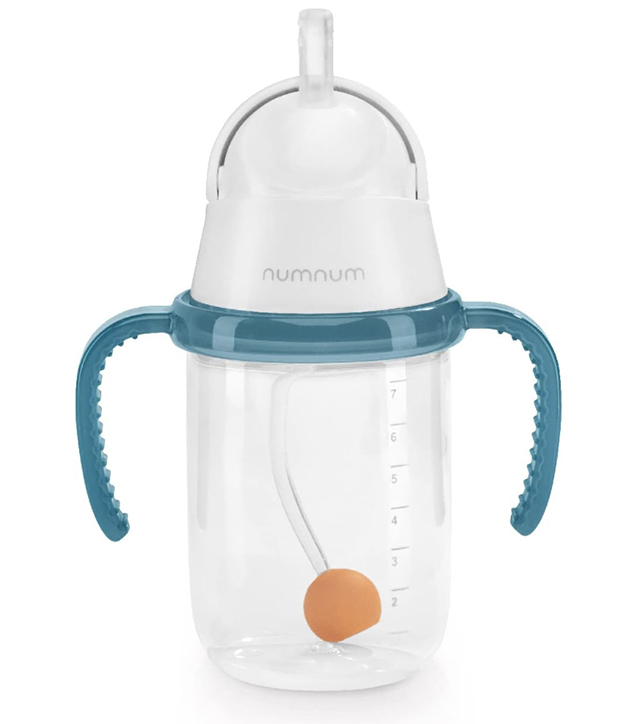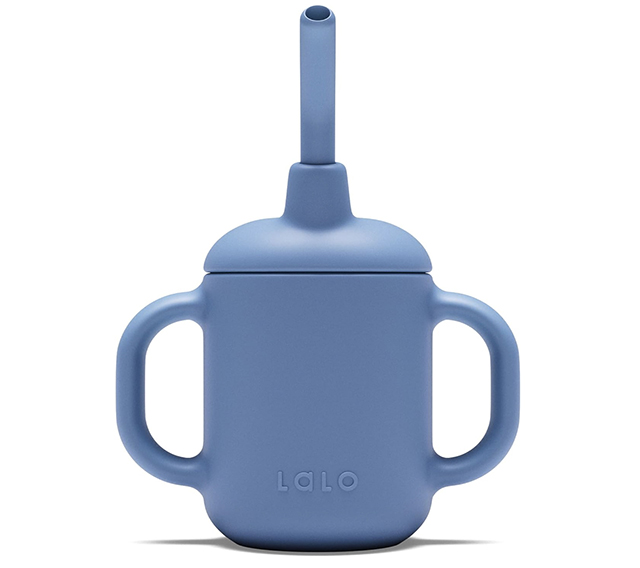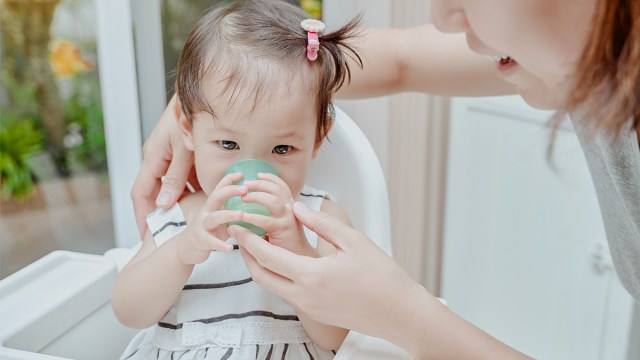We all know that drinking water is important: it’s healthy, keeps us hydrated, and helps our digestion flow. But what about babies? Do they have the same need for H2O? Is it even safe? As a dietitian, this is a question I hear a lot; as a mom of three, I’ve had lots of experience putting my advice into action. So we’re breaking down everything you need to know about giving water to your baby.
When can babies have water?
Babies get all of their fluids from breastmilk and formula, so they don’t actually need any other drinks before they turn one. However, when your infant hits the 6-month mark, you can start giving them small sips of water to get them used to it. It’s important not to offer water before 6 months because too much of it can fill up those pint-sized tummies and take away space needed for the essential calories and nutrients they get from breastmilk or formula.
How much water should they drink?
Until your baby is a year old, the American Academy of Pediatrics recommends sticking to 4-8 ounces per day, so you only want to offer small sips of water. Think of it this way: babies aged 6-12 months can drink a maximum of about half to one cup of water. Once they hit a year, you’re looking at 4 cups of beverages per day, ideally water and/or milk.
Why is water important for babies?
Although it doesn’t really provide any health benefits for babies, it’s important to introduce water at 6 months to help your infant get used to the flavor, which will start building their healthy drinking habits. We want water to become their go-to drink instead of juice and a little practice goes a long way.
Related: 6 Common Mistakes Parents Make When Starting Solids
Another important reason to introduce water is that it’s an opportunity for babies to start learning how to drink from a cup. Infants are fast learners and eager to try new things, so introducing a cup now will help them develop essential oral motor skills before they turn one.
How do we offer it?
When your baby is 6 months old it’s a good time to introduce a cup. You can offer water in an open cup or a straw cup, both of which help promote oral motor development and cup-drinking skills. Skip the sippy cups with hard spouts because they can actually get in the way of your kiddo’s speech and oral motor development.
The AAP recommends weaning off bottles between 12-18 months, and there’s no reason to offer water in a bottle since it doesn’t help babies develop oral motor skills. Using a cup gives them plenty of practice before they fully wean off bottles.
5 tips when offering water to your baby
Here are some tried and true tips for introducing H2O to your infant:
1. It takes time and practice
Just like any new skill, babies won’t master drinking water right away. It takes time and practice. They’re not only getting used to a new taste and texture but also learning how to drink from a cup. Consistency is key, so give your baby a chance to practice every day.
2. Adopt a hands-on approach
“Water is thinner than breast milk or formula, so be sure that you give it safely, in a way your baby won’t cough or choke,” says Claire McCarthy MD, a pediatrician at Boston Children’s Hospital and Scientific Advisor for EllaOla. With that in mind, only fill your baby’s cup with a tiny bit of water while they practice. Keep a close eye, controlling the cup’s flow and monitoring how much they’re drinking to ensure that they’re safe and comfortable. During the early days, you’ll likely have to hold the cup for them, especially if it’s an open cup.
3. Tap water is just fine
There’s no need to spend extra money on bottled water for your baby. “Tap water is fine,” says McCarthy, “unless you have well water that isn’t fully tested or you have reason to think your tap water may be contaminated.” As long as your tap water is safe, go ahead and let your baby drink it.
4. Make it part of your routine
You can offer tiny sips of water at mealtime. This helps both you and your baby get into the habit of practicing cup drinking at specific times each day.
5. Don’t force it
If your baby is rejecting water or struggling with a cup, don’t stress. It’s all new to them—the taste, the consistency, the whole experience—so it might take some time and practice. Don’t push it, and remember that being consistent is important. One helpful tip is to sip water along with your infant. Babies love to imitate everything you do!
Some of our favorite first cups:
Our favorite straw cups have soft and flexible straws to make it easier for your baby to sip. If you want to try an open cup, go for a small one that fits tiny hands, which can strengthen self-feeding skills and build self-confidence.
1. ezpz Mini Cup and Straw Training System

This cup can be used as both an open cup and a straw cup. Plus, it’s weighted to tip less easily, compact for little hands to hold, and made from soft, flexible silicone. $17.49, Amazon.
2. NumNum Weighted Straw Cup

This one’s a great choice because it’s designed for easy drinking thanks to its angled, weighted, and valveless straw, removable handles, and sensory bumps for correct lip placement. $14.99, Amazon.
3. Lalo Little Cup

Easy-grip handles make this silicone cup a great option. It can be used as an open cup or with its cool angled straw that makes sipping so much easier. $15.99, Amazon.
3 signs of dehydration in babies
McCarthy shares three signs to watch for if you suspect your infant isn’t getting enough fluids:
- Fewer wet diapers than usual (Your baby should be wetting a diaper about every six hours, but if they’re dehydrated their body will retain fluid instead of releasing it.)
- Dry mouth or crying without tears
- Unusually fussy, irritable, and sleepy
If you think your baby may be dehydrated, contact your pediatrician as soon as possible. Seek immediate medical attention if they’re under 6 months.
While it might not be time for baby’s first Stanley cup (unless it’s this one), you’re well on your way to introducing your little to the refreshing world of water. So grab a few dish towels for sopping up spills and make sure your phone’s nearby, because a tiny baby holding a tiny cup is too cute for words.











